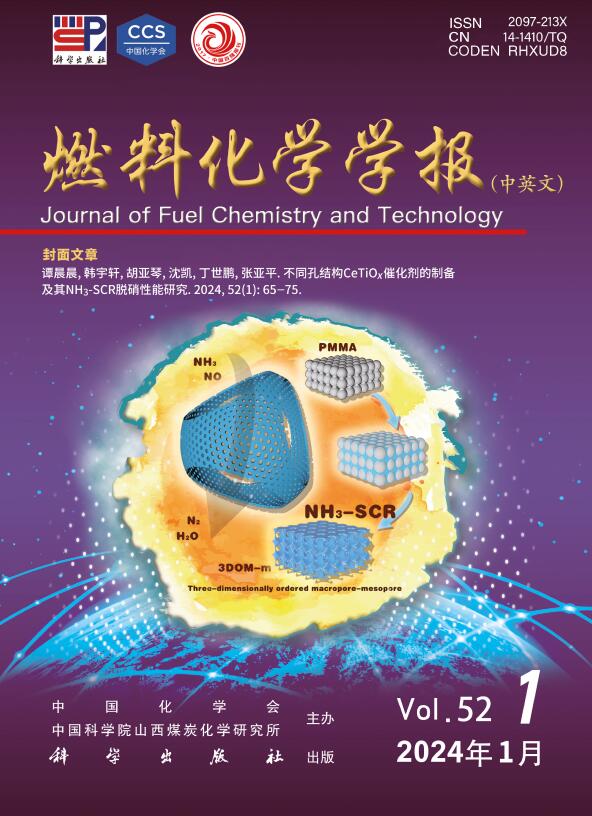Synthesis of FeOx-supported nano-silver catalyst and the mechanism of electrocatalytic epoxidation of propylene
Q3 Energy
引用次数: 0
Abstract
The electrochemical oxidation of propylene offers a promising green process route for propylene oxide (PO) synthesis. However, due to complex by-products and low yields, its development has been hampered. Therefore, it is crucial to explore the reaction mechanism of propylene epoxidation to guide the targeted design of efficient catalysts. In this work, FeOx-supported nano-silver catalysts (Ag-Fe2O3) were designed to achieve the efficient utilization of noble metal Ag to use for the electro-catalytic epoxidation of propylene, and the Ag loading in Fe2O3 was regulated by a hydrothermal method combined with a co-precipitation method. When the loading of Ag in Fe2O3 is 1.82%, it effectively enhanced the efficiency of the propylene epoxidation reaction, with the Faraday efficiency of 26.2% for PO, and its performance was superior to that of Fe2O3 and other samples with different loadings. The bifunctional mechanism was clarified by in situ attenuated total reflection surface-enhanced infrared absorption spectroscopy (ATR-SEIRAS), where propylene was adsorbed on the surface of Fe2O3 and the nano-Ag sites promoted the generation of reactive oxygen species such as *O and *OOH. This work elucidates synergistic catalytic effect between metal and support, provides new mechanistic insights for the electrochemical epoxidation of propylene, and offers possible theoretical guidance for the design of high-performance catalysts.
feox负载纳米银催化剂的合成及丙烯电催化环氧化机理
丙烯的电化学氧化为合成环氧丙烷(PO)提供了一条很有前途的绿色工艺路线。但由于其副产品复杂、产率低,制约了其发展。因此,探索丙烯环氧化反应机理,指导有针对性地设计高效催化剂至关重要。本文设计了feox负载的纳米银催化剂(Ag-Fe2O3),实现了贵金属Ag在丙烯电催化环氧化反应中的高效利用,并采用水热法结合共沉淀法调节了Fe2O3中Ag的负载。Fe2O3中Ag的掺量为1.82%时,能有效提高丙烯环氧化反应的效率,PO的法拉第效率为26.2%,性能优于Fe2O3和其他不同掺量样品。通过原位衰减全反射表面增强红外吸收光谱(ATR-SEIRAS)研究了双功能机理,其中丙烯吸附在Fe2O3表面,纳米ag位点促进了*O和*OOH等活性氧的生成。本研究阐明了金属与载体之间的协同催化作用,为丙烯的电化学环氧化反应提供了新的机理认识,并为高性能催化剂的设计提供了可能的理论指导。
本文章由计算机程序翻译,如有差异,请以英文原文为准。
求助全文
约1分钟内获得全文
求助全文
来源期刊

燃料化学学报
Chemical Engineering-Chemical Engineering (all)
CiteScore
2.80
自引率
0.00%
发文量
5825
期刊介绍:
Journal of Fuel Chemistry and Technology (Ranliao Huaxue Xuebao) is a Chinese Academy of Sciences(CAS) journal started in 1956, sponsored by the Chinese Chemical Society and the Institute of Coal Chemistry, Chinese Academy of Sciences(CAS). The journal is published bimonthly by Science Press in China and widely distributed in about 20 countries. Journal of Fuel Chemistry and Technology publishes reports of both basic and applied research in the chemistry and chemical engineering of many energy sources, including that involved in the nature, processing and utilization of coal, petroleum, oil shale, natural gas, biomass and synfuels, as well as related subjects of increasing interest such as C1 chemistry, pollutions control and new catalytic materials. Types of publications include original research articles, short communications, research notes and reviews. Both domestic and international contributors are welcome. Manuscripts written in Chinese or English will be accepted. Additional English titles, abstracts and key words should be included in Chinese manuscripts. All manuscripts are subject to critical review by the editorial committee, which is composed of about 10 foreign and 50 Chinese experts in fuel science. Journal of Fuel Chemistry and Technology has been a source of primary research work in fuel chemistry as a Chinese core scientific periodical.
 求助内容:
求助内容: 应助结果提醒方式:
应助结果提醒方式:


